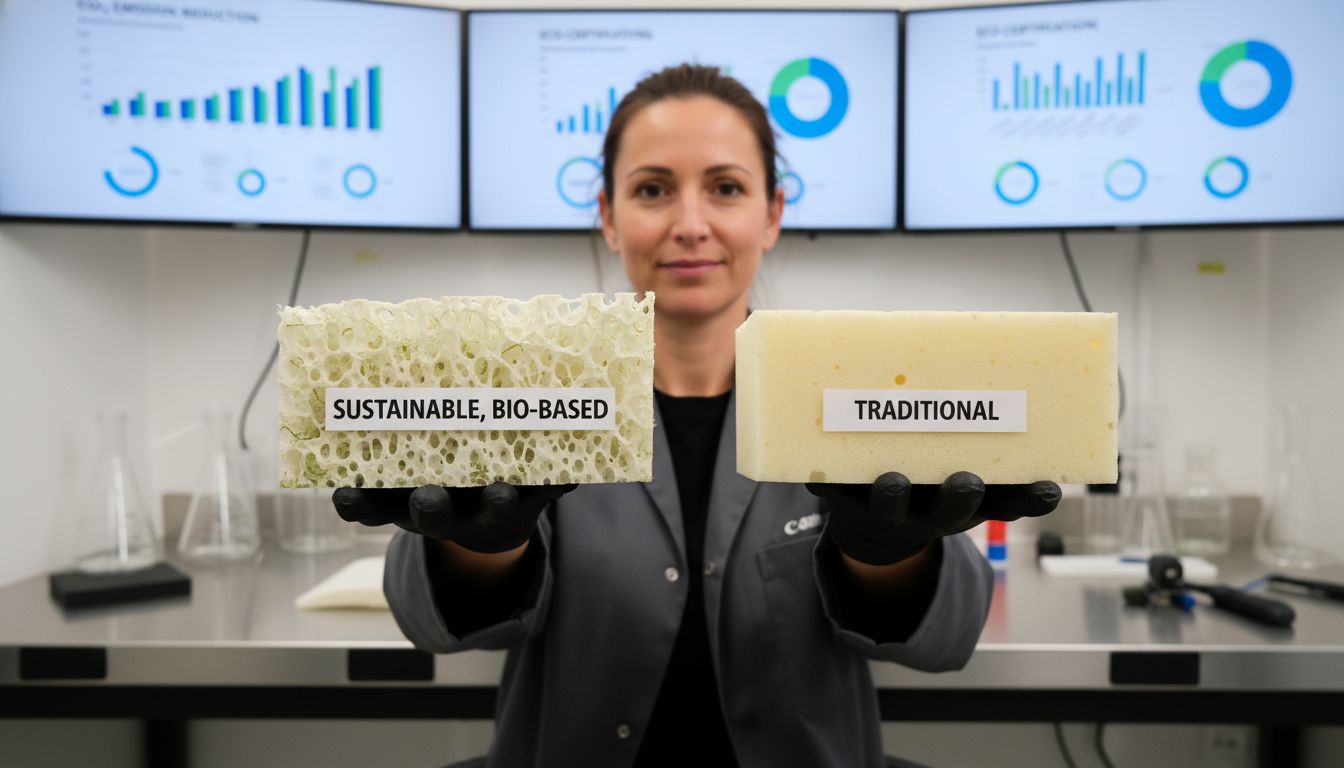Did you know that over 1.5 million tons of mattress waste end up in landfills every year? As more people embrace outdoor adventures, the demand for comfortable and eco-friendly sleeping solutions continues to rise. Sustainable memory foam addresses this need by combining innovative bio-based materials with lower emissions and responsible manufacturing. This new generation of memory foam offers the comfort outdoor enthusiasts expect while reducing the environmental footprint of each camping trip.
Table of Contents
- Defining Sustainable Memory Foam Materials
- Types Of Eco-Friendly Memory Foam
- How Sustainable Memory Foam Is Made
- Benefits For Outdoor And Camping Use
- Comparing Sustainable And Traditional Foams
Key Takeaways
| Point | Details |
|---|---|
| Sustainable Materials | Sustainable memory foam is produced from bio-based materials, significantly reducing environmental impact compared to traditional options. |
| Certifications | Certifications like CertiPUR-US ensure that sustainable memory foams meet high environmental and health standards. |
| Performance | Sustainable memory foams offer comparable performance in comfort and insulation to traditional foams while prioritizing ecological responsibility. |
| Eco-Friendly Choices | Choosing eco-friendly memory foams allows outdoor enthusiasts to enjoy comfort without compromising environmental values. |
Defining Sustainable Memory Foam Materials
Sustainable memory foam represents an innovative approach to creating comfortable outdoor sleeping materials while minimizing environmental impact. According to the Polyurethane Foam Association, these materials meet specific environmental and health standards that distinguish them from traditional memory foam products. Sustainable memory foam essentially combines comfort technology with ecological responsibility.
At its core, sustainable memory foam is characterized by several key attributes. These include:
- Production using bio-based materials derived from renewable living organisms
- Manufacturing processes that reduce carbon emissions
- Elimination of harmful chemical compounds
- Low volatile organic compound (VOC) emissions
As research from bio-material experts indicates, these materials are not just environmentally friendly but also provide comparable performance to traditional memory foam. Understanding the Role of Memory Foam Outdoors highlights how modern sustainable materials can deliver exceptional comfort without compromising ecological principles.
The certification process plays a crucial role in defining sustainable memory foam. Rigorous standards like CertiPUR-US ensure that these materials meet stringent environmental and health criteria. This means consumers can enjoy high-performance sleeping surfaces that align with responsible environmental practices, making sustainable memory foam an intelligent choice for outdoor enthusiasts who prioritize both comfort and ecological consciousness.
Types Of Eco-Friendly Memory Foam
Eco-friendly memory foam represents a significant innovation in sustainable sleeping materials, offering outdoor enthusiasts environmentally conscious options without compromising comfort. According to research from sleep technology experts, these advanced materials come in several distinctive types that prioritize both performance and environmental responsibility.
One prominent category is plant-based memory foam. As reported by sleep industry sources, these foams replace a portion of traditional petroleum-based components with renewable plant-derived oils. This approach significantly reduces reliance on non-renewable resources and lowers production emissions. The key characteristics of plant-based memory foam include:
- Reduced carbon footprint
- Increased use of renewable agricultural materials
- Lower volatile organic compound (VOC) emissions
- Comparable comfort to traditional memory foam
Another innovative type is specialized eco-friendly memory foam. According to materials research, this includes advanced variations like bamboo charcoal and graphite memory foam. Essential Memory Foam Mattress Setup for Outdoor Comfort highlights how these materials offer unique benefits. Bamboo charcoal memory foam, for instance, utilizes bamboo - a rapidly renewable resource - while graphite memory foam incorporates graphene particles to enhance strength and breathability.
These sustainable memory foam types demonstrate that environmental responsibility and high-performance outdoor sleeping solutions are not mutually exclusive. By choosing eco-friendly memory foam, outdoor enthusiasts can enjoy superior comfort while making a positive impact on the environment.
How Sustainable Memory Foam Is Made
The production of sustainable memory foam represents a sophisticated process that transforms traditional manufacturing approaches by prioritizing environmental responsibility. According to sleep technology research, this innovative approach fundamentally reimagines how memory foam materials are created, focusing on reducing ecological impact while maintaining superior performance.
At the core of sustainable memory foam production is the strategic substitution of materials. As reported by the Sleep Foundation, manufacturers replace traditional petroleum-based polyols with plant-derived alternatives like soy oil. This critical transformation involves:
- Utilizing renewable agricultural resources
- Reducing dependency on fossil fuel-based components
- Minimizing carbon emissions during production
- Maintaining comparable material performance
The biofoam creation process takes sustainability even further. According to biological materials research, these advanced foams incorporate biological materials such as soy oil and cellulose, offering a comprehensive alternative to conventional petroleum-based manufacturing. 7 Outdoor Sleeping Arrangement Ideas for Ultimate Comfort illustrates how these innovative materials can enhance outdoor sleeping experiences while supporting environmental conservation.
Manufacturers employ sophisticated techniques to ensure that sustainable memory foam meets rigorous performance and environmental standards. By carefully selecting renewable ingredients, implementing energy-efficient production methods, and focusing on reduced chemical interventions, they create memory foam products that deliver exceptional comfort without compromising ecological integrity.
 This approach represents a significant step toward more responsible and environmentally conscious manufacturing in the outdoor sleeping industry.
This approach represents a significant step toward more responsible and environmentally conscious manufacturing in the outdoor sleeping industry.
Benefits For Outdoor And Camping Use
Sustainable memory foam has revolutionized outdoor sleeping solutions by offering unprecedented comfort and environmental responsibility for camping enthusiasts. The unique properties of these innovative materials make them an ideal choice for adventurers seeking both performance and ecological consciousness.
Thermal performance stands out as a primary advantage. According to research on polyurethane foam, these materials provide exceptional thermal insulation characteristics. The low density and remarkable thermal conductivity properties mean campers can enjoy:
- Consistent temperature regulation
- Reduced heat loss during cold nights
- Lightweight insulation without bulky materials
- Enhanced comfort in varied outdoor environments
The lightweight and adaptive nature of sustainable memory foam makes it particularly suited for outdoor applications. Biofoam research highlights its porous structure, which contributes to remarkable versatility in camping scenarios. 7 Camping Comfort Hacks for a Great Outdoor Experience demonstrates how these innovative materials can transform outdoor sleeping experiences by providing compact, responsive cushioning that adapts to different terrains and temperature conditions.
Beyond physical comfort, sustainable memory foam represents an environmentally conscious choice for outdoor enthusiasts. By selecting materials that minimize ecological impact, campers can enjoy high-performance sleeping solutions while supporting sustainable manufacturing practices. This approach ensures that adventure and environmental responsibility can coexist seamlessly, allowing travelers to rest comfortably knowing their gear reflects a commitment to protecting the natural landscapes they explore.
Comparing Sustainable And Traditional Foams
The landscape of foam materials has undergone a significant transformation, with sustainable alternatives challenging the long-standing dominance of traditional petroleum-based foams. Understanding the key differences between these materials reveals a compelling narrative of technological innovation and environmental responsibility.
Traditional polyurethane foams have long been the standard for thermal insulation and cushioning. According to materials research, these thermosetting polymers were primarily derived from petroleum-based resources, characterized by their consistent performance but significant environmental drawbacks. In contrast, sustainable foams offer a fundamentally different approach, featuring:
- Renewable resource-based composition
- Reduced carbon footprint
- Lower chemical emissions
- Comparable performance to traditional materials
The manufacturing process represents another critical point of differentiation. While traditional foams rely heavily on fossil fuel derivatives, bio-based materials introduce a revolutionary alternative. 7 Essential Outdoor Sleep Solutions List for Comfort highlights how sustainable materials derive their core components from living organisms, creating a more environmentally conscious production cycle that significantly reduces ecological impact.
Performance metrics tell an equally compelling story. Contrary to early assumptions, sustainable foams now match or exceed traditional materials in critical areas like durability, thermal regulation, and comfort. This technological leap demonstrates that environmental responsibility need not come at the cost of product quality, offering outdoor enthusiasts a compelling choice that supports both personal comfort and global ecological preservation.
Here’s a comparison of sustainable and traditional memory foams:
| Feature | Sustainable Memory Foam | Traditional Memory Foam |
|---|---|---|
| Main Materials | Bio-based oils Renewable resources |
Petroleum-based chemicals |
| Carbon Footprint | Reduced | High |
| VOC Emissions | Low | Higher |
| Environmental Impact | Eco-friendly Responsible sourcing |
Greater ecological harm |
| Comfort & Performance | Comparable to traditional | Consistent & established |
| Certifications | CertiPUR-US Eco-labels |
Fewer or none |
Discover Comfort and Care with Sustainable Memory Foam at Hazli Collection
The challenge of finding outdoor sleeping gear that balances comfort with environmental responsibility is real. This article explores sustainable memory foam, highlighting how materials like plant-based oils and biofoam create cozy, eco-friendly solutions. If you want your camping gear to perform brilliantly while protecting nature, understanding concepts like reduced carbon footprints and low VOC emissions matters.
Experience the perfect blend of comfort, durability, and sustainability with our exclusive range of memory foam mattresses designed specifically for outdoor adventures. Our products reflect the same values detailed in this article, offering advanced thermal insulation and lightweight support that adapts to any terrain. Let your next outdoor getaway be kind to both your body and the environment.

Ready to upgrade your camping comfort with sustainable memory foam products you can trust? Visit Hazli Collection now to explore our selection and find the ideal mattress for your adventures. Learn more about how to set up your gear for the ultimate outdoor experience in our Essential Memory Foam Mattress Setup for Outdoor Comfort guide. For inspiration on making every night outdoors extraordinary, check out our tips in 7 Outdoor Sleeping Arrangement Ideas for Ultimate Comfort. Don’t wait to enjoy nature without sacrificing comfort or your commitment to sustainability.
Frequently Asked Questions
What is sustainable memory foam?
Sustainable memory foam is an innovative sleeping material that combines comfort technology with environmental responsibility. It is produced using bio-based materials, reducing carbon emissions and eliminating harmful chemicals.
How is sustainable memory foam manufactured?
Sustainable memory foam is made by replacing traditional petroleum-based polyols with plant-derived alternatives. This process minimizes ecological impact by utilizing renewable resources and energy-efficient manufacturing techniques.
What are the benefits of using sustainable memory foam for outdoor sleeping?
Sustainable memory foam offers exceptional thermal insulation, lightweight comfort, and adaptability to various terrains. It also reflects an environmentally conscious choice, supporting sustainable manufacturing practices.
How does sustainable memory foam compare to traditional memory foam?
Sustainable memory foam uses bio-based and renewable materials, resulting in a lower carbon footprint and reduced VOC emissions. While offering comparable performance, it is more environmentally friendly than traditional petroleum-based foams.
Recommended
- Understanding the Role of Memory Foam Outdoors – Hazli Collection
- Essential Memory Foam Mattress Setup for Outdoor Comfort – Hazli Collection
- 7 Outdoor Sleeping Arrangement Ideas for Ultimate Comfort – Hazli Collection
- Complete Camp Mattress Cleaning Guide for Outdoor Comfort – Hazli Collection
- 7 Types of Sustainable Materials for Eco-Friendly Living – The Cork Store

